Siqi Kou
Thinking with Generated Images
May 28, 2025Abstract:We present Thinking with Generated Images, a novel paradigm that fundamentally transforms how large multimodal models (LMMs) engage with visual reasoning by enabling them to natively think across text and vision modalities through spontaneous generation of intermediate visual thinking steps. Current visual reasoning with LMMs is constrained to either processing fixed user-provided images or reasoning solely through text-based chain-of-thought (CoT). Thinking with Generated Images unlocks a new dimension of cognitive capability where models can actively construct intermediate visual thoughts, critique their own visual hypotheses, and refine them as integral components of their reasoning process. We demonstrate the effectiveness of our approach through two complementary mechanisms: (1) vision generation with intermediate visual subgoals, where models decompose complex visual tasks into manageable components that are generated and integrated progressively, and (2) vision generation with self-critique, where models generate an initial visual hypothesis, analyze its shortcomings through textual reasoning, and produce refined outputs based on their own critiques. Our experiments on vision generation benchmarks show substantial improvements over baseline approaches, with our models achieving up to 50% (from 38% to 57%) relative improvement in handling complex multi-object scenarios. From biochemists exploring novel protein structures, and architects iterating on spatial designs, to forensic analysts reconstructing crime scenes, and basketball players envisioning strategic plays, our approach enables AI models to engage in the kind of visual imagination and iterative refinement that characterizes human creative, analytical, and strategic thinking. We release our open-source suite at https://github.com/GAIR-NLP/thinking-with-generated-images.
Which Data Attributes Stimulate Math and Code Reasoning? An Investigation via Influence Functions
May 26, 2025Abstract:Large language models (LLMs) have demonstrated remarkable reasoning capabilities in math and coding, often bolstered by post-training on the chain-of-thoughts (CoTs) generated by stronger models. However, existing strategies for curating such training data predominantly rely on heuristics, limiting generalizability and failing to capture subtleties underlying in data. To address these limitations, we leverage influence functions to systematically attribute LLMs' reasoning ability on math and coding to individual training examples, sequences, and tokens, enabling deeper insights into effective data characteristics. Our Influence-based Reasoning Attribution (Infra) uncovers nontrivial cross-domain effects across math and coding tasks: high-difficulty math examples improve both math and code reasoning, while low-difficulty code tasks most effectively benefit code reasoning. Based on these findings, we introduce a simple yet effective dataset reweighting strategy by flipping task difficulty, which doubles AIME24 accuracy from 10\% to 20\% and boosts LiveCodeBench accuracy from 33.8\% to 35.3\% for Qwen2.5-7B-Instruct. Moreover, our fine-grained attribution reveals that the sequence-level exploratory behaviors enhance reasoning performance in both math and code, and the token-level influence patterns are distinct for math and code reasoning: the former prefers natural language logic connectors and the latter emphasizes structural syntax.
Orthus: Autoregressive Interleaved Image-Text Generation with Modality-Specific Heads
Nov 28, 2024
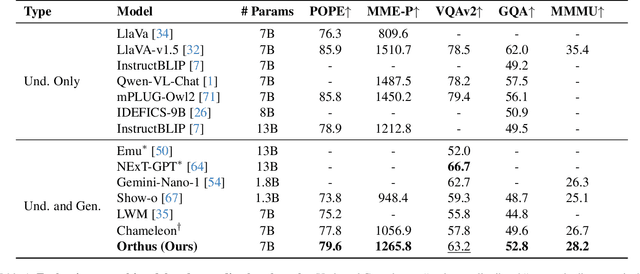
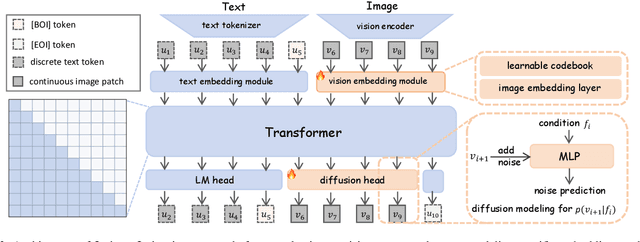
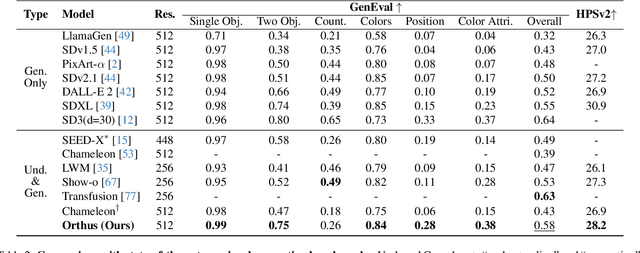
Abstract:We introduce Orthus, an autoregressive (AR) transformer that excels in generating images given textual prompts, answering questions based on visual inputs, and even crafting lengthy image-text interleaved contents. Unlike prior arts on unified multimodal modeling, Orthus simultaneously copes with discrete text tokens and continuous image features under the AR modeling principle. The continuous treatment of visual signals minimizes the information loss for both image understanding and generation while the fully AR formulation renders the characterization of the correlation between modalities straightforward. The key mechanism enabling Orthus to leverage these advantages lies in its modality-specific heads -- one regular language modeling (LM) head predicts discrete text tokens and one diffusion head generates continuous image features conditioning on the output of the backbone. We devise an efficient strategy for building Orthus -- by substituting the Vector Quantization (VQ) operation in the existing unified AR model with a soft alternative, introducing a diffusion head, and tuning the added modules to reconstruct images, we can create an Orthus-base model effortlessly (e.g., within mere 72 A100 GPU hours). Orthus-base can further embrace post-training to better model interleaved images and texts. Empirically, Orthus surpasses competing baselines including Show-o and Chameleon across standard benchmarks, achieving a GenEval score of 0.58 and an MME-P score of 1265.8 using 7B parameters. Orthus also shows exceptional mixed-modality generation capabilities, reflecting the potential for handling intricate practical generation tasks.
MatryoshkaKV: Adaptive KV Compression via Trainable Orthogonal Projection
Oct 16, 2024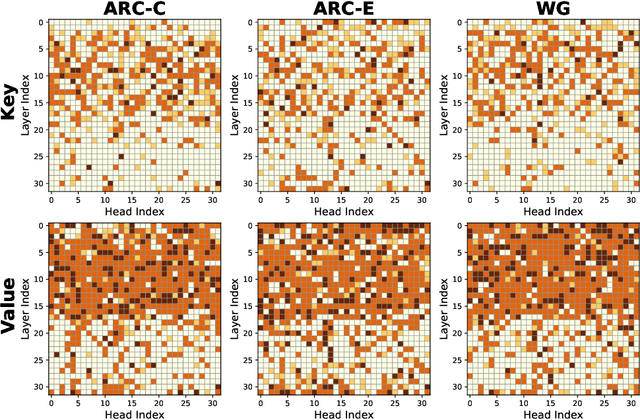



Abstract:KV cache has become a de facto technique for the inference of large language models (LLMs), where tensors of shape (layer number, head number, sequence length, feature dimension) are introduced to cache historical information for self-attention. As the size of the model and data grows, the KV cache can quickly become a bottleneck within the system in both storage and memory transfer. To address this, prior studies usually focus on the first three axes of the cache tensors for compression. This paper supplements them, focusing on the feature dimension axis, by utilizing low-rank projection matrices to transform the cache features into spaces with reduced dimensions. We begin by investigating the canonical orthogonal projection method for data compression through principal component analysis (PCA). We observe the issue with PCA projection where significant performance degradation is observed at low compression rates. To bridge the gap, we propose to directly tune the orthogonal projection matrices with a distillation objective using an elaborate Matryoshka training strategy. After training, we adaptively search for the optimal compression rates for various layers and heads given varying compression budgets. Compared to previous works, our method can easily embrace pre-trained LLMs and hold a smooth tradeoff between performance and compression rate. We empirically witness the high data efficiency of our training procedure and find that our method can sustain over 90% performance with an average KV cache compression rate of 60% (and up to 75% in certain extreme scenarios) for popular LLMs like LLaMA2-7B-base and Mistral-7B-v0.3-base.
CLLMs: Consistency Large Language Models
Mar 08, 2024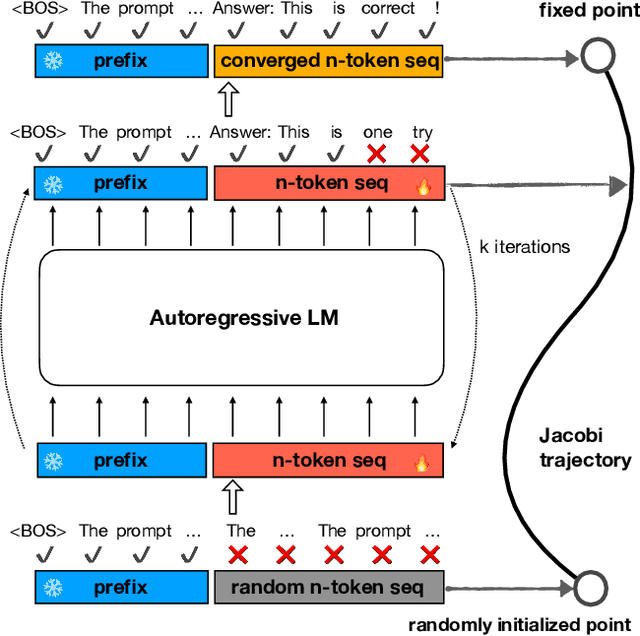
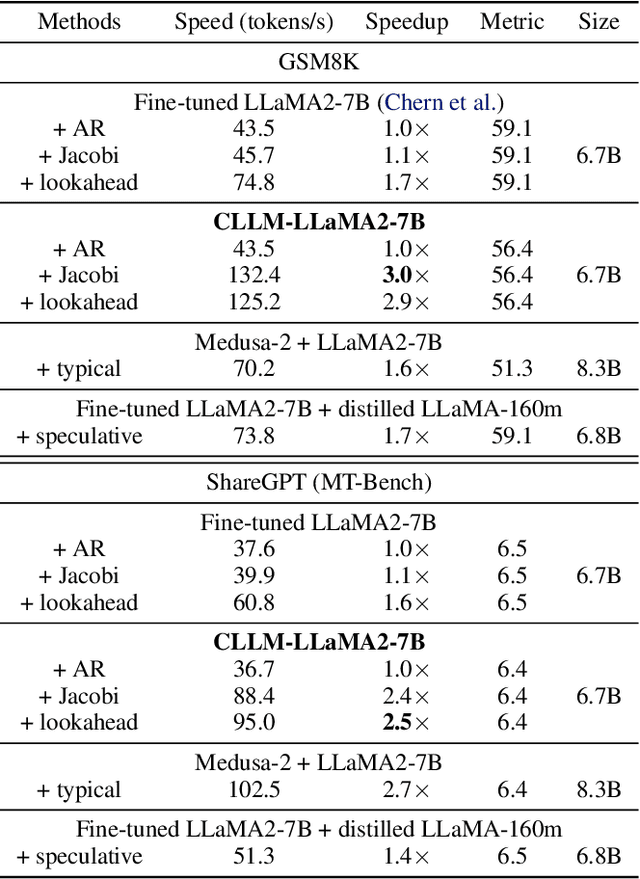

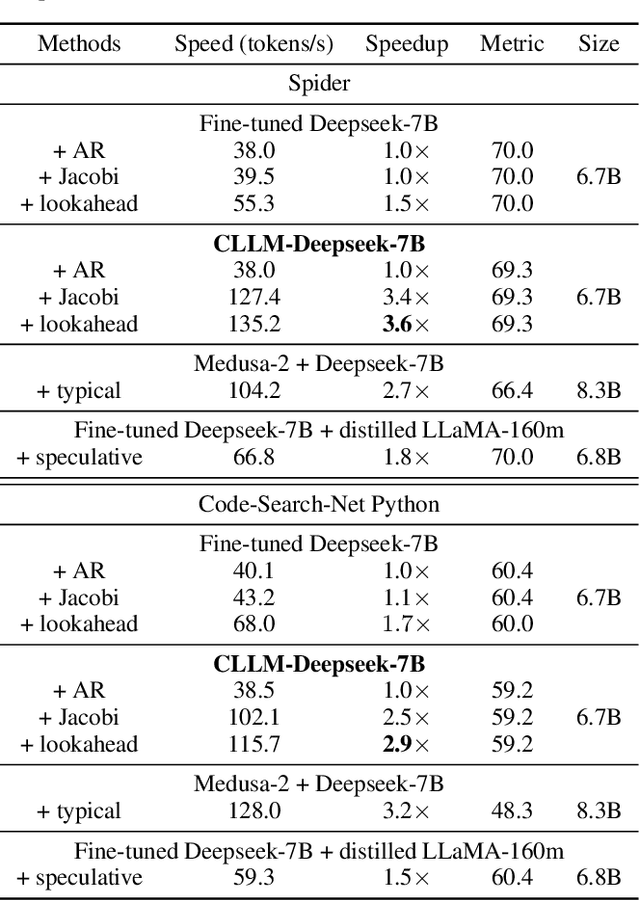
Abstract:Parallel decoding methods such as Jacobi decoding show promise for more efficient LLM inference as it breaks the sequential nature of the LLM decoding process and transforms it into parallelizable computation. However, in practice, it achieves little speedup compared to traditional autoregressive (AR) decoding, primarily because Jacobi decoding seldom accurately predicts more than one token in a single fixed-point iteration step. To address this, we develop a new approach aimed at realizing fast convergence from any state to the fixed point on a Jacobi trajectory. This is accomplished by refining the target LLM to consistently predict the fixed point given any state as input. Extensive experiments demonstrate the effectiveness of our method, showing 2.4$\times$ to 3.4$\times$ improvements in generation speed while preserving generation quality across both domain-specific and open-domain benchmarks.
BayesDiff: Estimating Pixel-wise Uncertainty in Diffusion via Bayesian Inference
Oct 17, 2023



Abstract:Diffusion models have impressive image generation capability, but low-quality generations still exist, and their identification remains challenging due to the lack of a proper sample-wise metric. To address this, we propose BayesDiff, a pixel-wise uncertainty estimator for generations from diffusion models based on Bayesian inference. In particular, we derive a novel uncertainty iteration principle to characterize the uncertainty dynamics in diffusion, and leverage the last-layer Laplace approximation for efficient Bayesian inference. The estimated pixel-wise uncertainty can not only be aggregated into a sample-wise metric to filter out low-fidelity images but also aids in augmenting successful generations and rectifying artifacts in failed generations in text-to-image tasks. Extensive experiments demonstrate the efficacy of BayesDiff and its promise for practical applications.
Phasic Content Fusing Diffusion Model with Directional Distribution Consistency for Few-Shot Model Adaption
Sep 07, 2023Abstract:Training a generative model with limited number of samples is a challenging task. Current methods primarily rely on few-shot model adaption to train the network. However, in scenarios where data is extremely limited (less than 10), the generative network tends to overfit and suffers from content degradation. To address these problems, we propose a novel phasic content fusing few-shot diffusion model with directional distribution consistency loss, which targets different learning objectives at distinct training stages of the diffusion model. Specifically, we design a phasic training strategy with phasic content fusion to help our model learn content and style information when t is large, and learn local details of target domain when t is small, leading to an improvement in the capture of content, style and local details. Furthermore, we introduce a novel directional distribution consistency loss that ensures the consistency between the generated and source distributions more efficiently and stably than the prior methods, preventing our model from overfitting. Finally, we propose a cross-domain structure guidance strategy that enhances structure consistency during domain adaptation. Theoretical analysis, qualitative and quantitative experiments demonstrate the superiority of our approach in few-shot generative model adaption tasks compared to state-of-the-art methods. The source code is available at: https://github.com/sjtuplayer/few-shot-diffusion.
 Add to Chrome
Add to Chrome Add to Firefox
Add to Firefox Add to Edge
Add to Edge